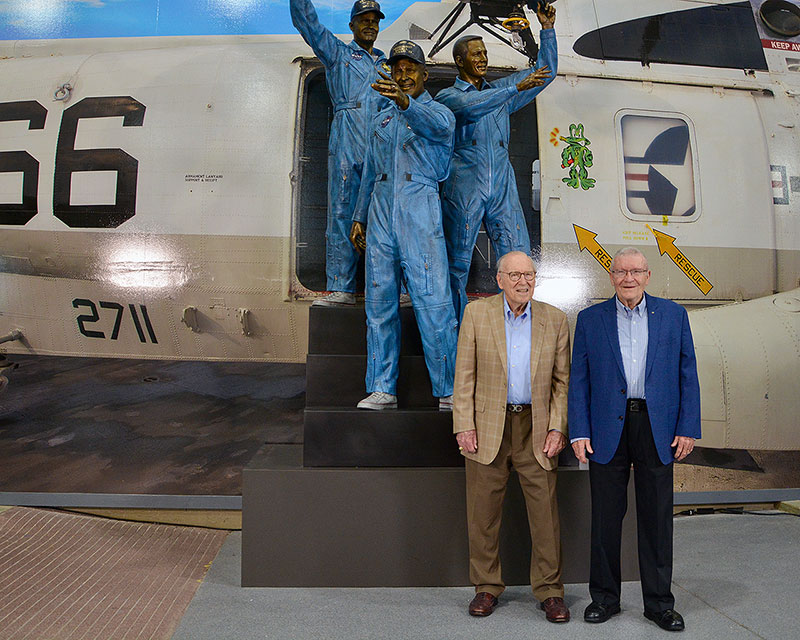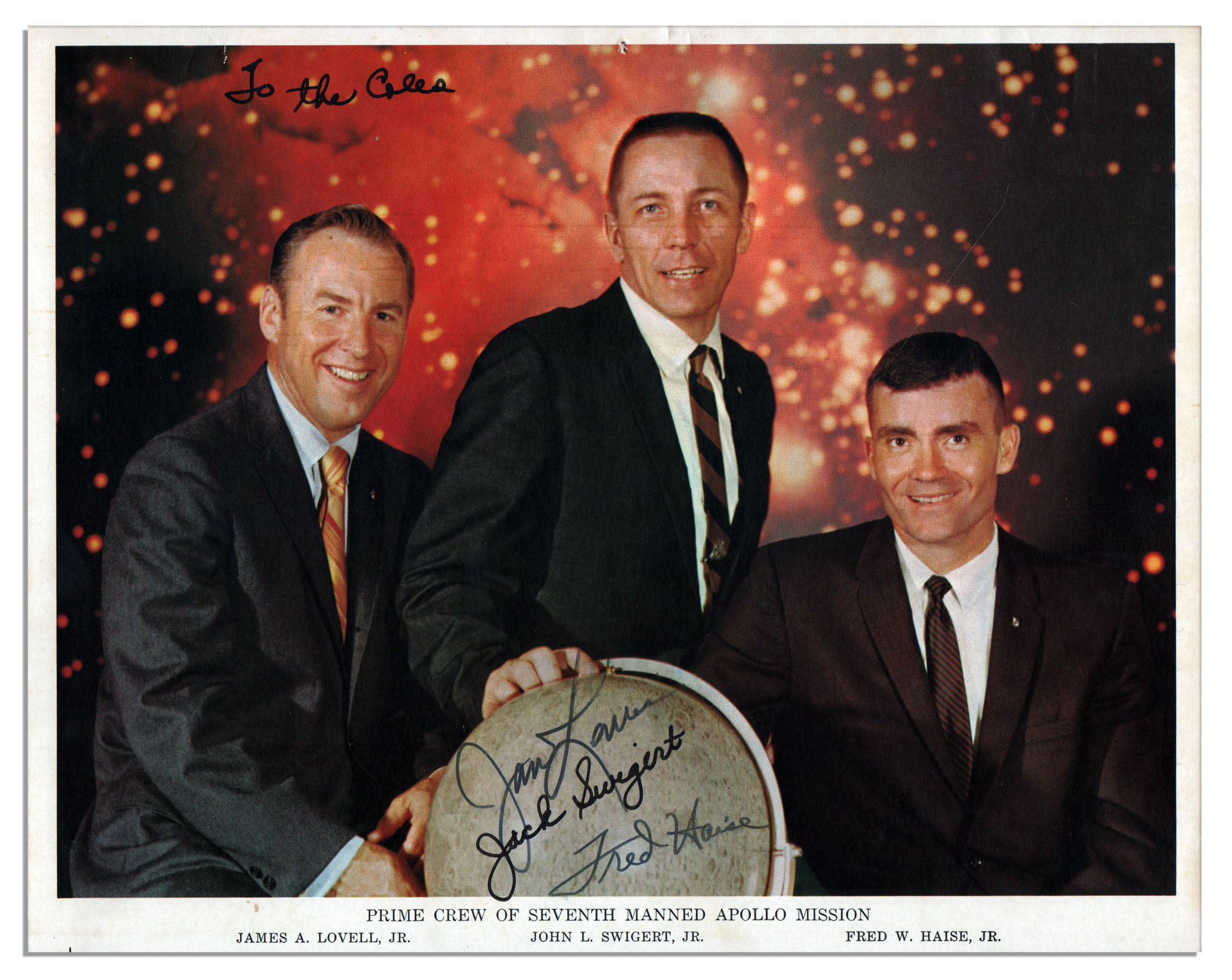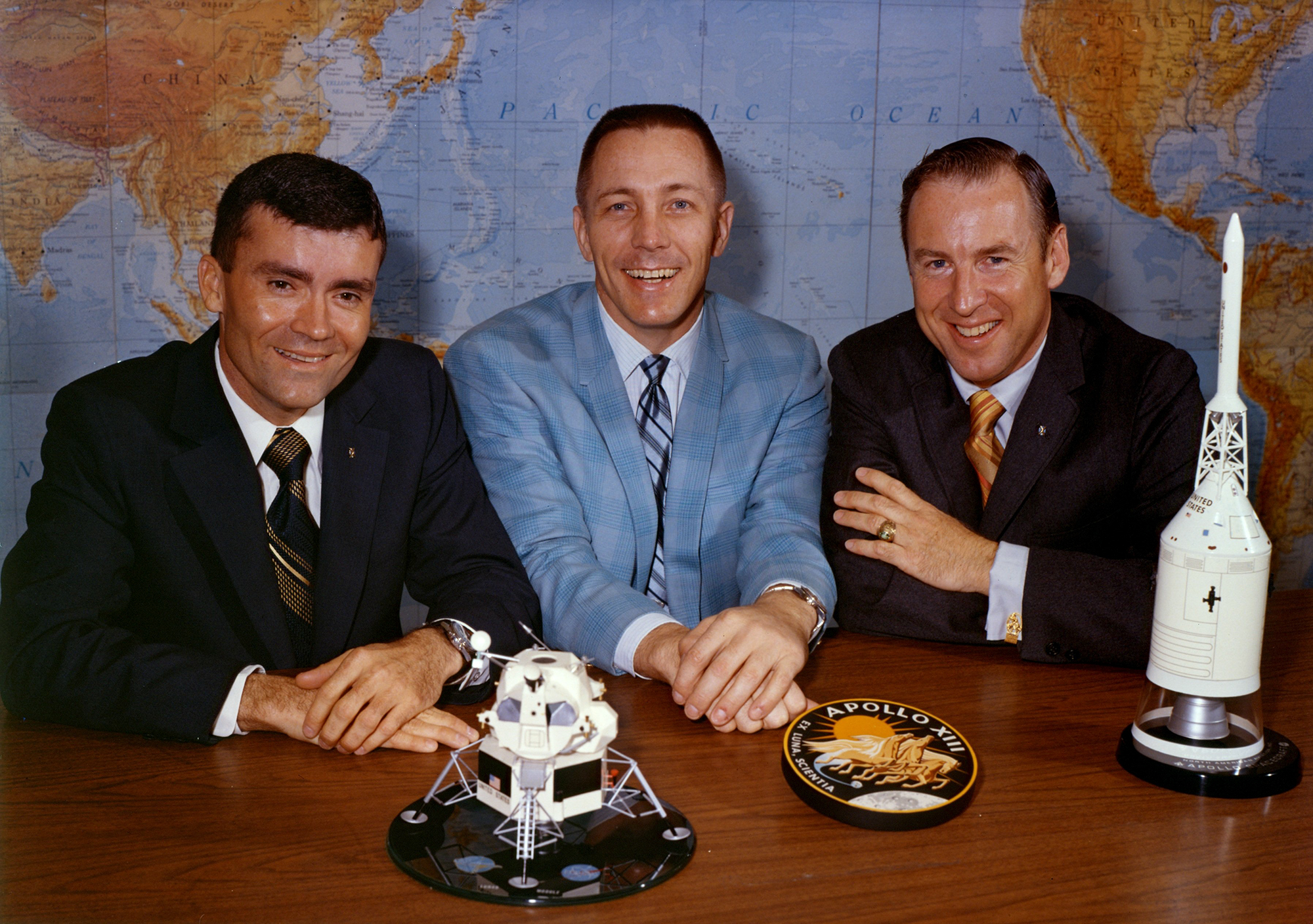
Apollo 13 astronauts raise a toast to their recovery with new statue collectSPACE
The spacecraft ferrying astronauts Jim Lovell, Jack Swigert and Fred Haise to their planned lunar landing had traveled just over 200,000 miles from Earth, and was approaching the moon's.

Fred Haise (left) Jim Lovell, and Ken Mattingly pose in front of the launch pad Stock Photo Alamy
In this April 10, 1970, photo, Apollo 13 astronauts, Fred Haise (from left), Jack Swigert and Jim Lovell gather for a photo on the day before launch.

Fred Haise, Jack Swigert, Jim Lovell
On board were astronauts James Lovell, John "Jack" Swigert and Fred Haise. Their mission was to reach the Fra Mauro highlands of the moon and explore the Imbrium Basin, conducting.

January 17, 1970 — Apollo 13 astronaut Jim Lovell (left) and Fred Haise during water egress
Apollo 13, U.S. spaceflight, launched on April 11, 1970, that suffered an oxygen tank explosion en route to the Moon, threatening the lives of three astronauts —commander Jim Lovell, lunar module pilot Fred Haise, and command module pilot Jack Swigert. Houston, we've had a problem Apollo 13 launch

Lot Detail Apollo 13 CrewSigned 10'' x 8'' Photo Issued by NASA Before The Nearly
US President Richard Nixon meets the Apollo 13 astronauts in Honolulu, Hawaii, after their safe return to Earth. From left to right (front row) Fred Haise, Jim Lovell, Richard Nixon and Jack Swigert.

Fred Haise (left) and Jim Lovell, the Apollo 11 Backup LM crew on the Sierra Blanca geology
Astronaut James A. Lovell. NASA Apollo 13: The Successful Failure On April 11, 1970, the powerful Saturn V rocket carrying the Apollo 13 mission launched from Kennedy Space Center propelling astronauts Jim Lovell, Fred Haise, and Jack Swigert on what was intended to be humanity's third lunar landing.

Apollo 13 astronauts Jim Lovell and Fred Haise during training at Cape Canaveral, 1970. (NASA
Jim Lovell, Jack Swigert and Fred Haise knew that their chances of returning safely to Earth were poor. For days, they lived in refrigerator-like temperatures with only six ounces of water.

For sale the numbers that stopped Apollo 13 getting lost in space The Times
Fred Haise, American astronaut, participant in the Apollo 13 mission (April 11-17, 1970), in which an intended Moon landing was canceled because of a rupture in a fuel-cell oxygen tank. The crew, which also included Jack Swigert and Jim Lovell, safely returned to Earth. Learn more about Haise's life and career.

Apollo 13 Clipart Photo Image fredhaisejackswigertandjimlovellposeonthedaybefore
Fred Wallace Haise Jr. ( / heɪz / HAYZ; [1] born November 14, 1933) is an American former NASA astronaut, engineer, fighter pilot with the U.S. Marine Corps and U.S. Air Force, and a test pilot. He is one of 24 people to have flown to the Moon, having flown as Lunar Module pilot on Apollo 13.

Apollo 13 astronauts Jim Lovell and Fred Haise during training at Cape Canaveral, 1970. (NASA
In 2010, forty years after Apollo 13, the Smithsonian's National Air and Space Museum welcomed Apollo 13 mission commander Jim Lovell, lunar module pilot Fred Haise, Apollo 16 command module pilot Ken Mattingly, and mission controller Gene Kranz for a panel discussion about that historic mission. Panel discussion about Apollo 13

Apollo 13 splashdown, James Lovell and Fred Haise, April 17, 1970 Apollo 13, Apollo space
Jim Lovell recounts the Apollo 13 disaster Fifty years later, the famous astronaut relives Apollo 13 — the Moon mission that almost didn't make it home. By Richard Talcott | Published: April.

‘Bored to Tears’ 45 Years Since the Unlucky Voyage of Apollo 13 (Part 1) AmericaSpace
Fred Haise Haise and fellow Apollo 13 crewmen, James A. Lovell and Jack Swigert converted their lunar module "Aquarius" into an effective lifeboat. Quick Facts Haise was inducted into the U.S. Astronaut Hall of Fame in 1997. Haise served with the U.S. Air Force as a tactical fighter pilot.

Apollo 13 astronauts Jim Lovell and Fred Haise during training at Cape Canaveral, 1970. (NASA
Charlie Duke, along with Jim Lovell and Fred Haise in Mission Control, during the Apollo 11 mission. In his distinctive southern drawl, Duke replied: "Roger, Tranquility. We copy you on the ground.

James Lovell and Fred Haise (2) Signed Photographs
BILOXI, Miss. (AP) — Fifty years after Apollo 13 blasted into space, carrying Biloxi, Mississippi native Fred Haise Jr., Commander James Lovell Jr. and John Swigert Jr. to the moon, the "unlucky 13" seems to be at work again. The 50th anniversary of the April 11, 1970 launch was to be marked with nine ceremonies across the country.

apollo 13 Jim Lovell and Fred Haise Birthday photo album, Nasa, Nasa history
With only 15 minutes of power left, astronauts Swigert, Jim Lovell and Fred Haise escaped to the "life boat" of the lunar module. Then-Goddard Center Director John Clark greets President Richard Nixon, who visited the center for an Apollo 13 briefing on April 14, 1970. At right is Henry Thompson, deputy director of manned flight support at Goddard.

S7034767 ( 228k or 935k ) Jack Swigert, Jim Lovell, and Fred Haise pose on the day before
Its commander Jim Lovell and pilot Fred Haise reflect on their fateful, flawed voyage to the moon By Robert Z. Pearlman Crew members of Apollo 13 exit a helicopter onto the USS Iwo Jima.